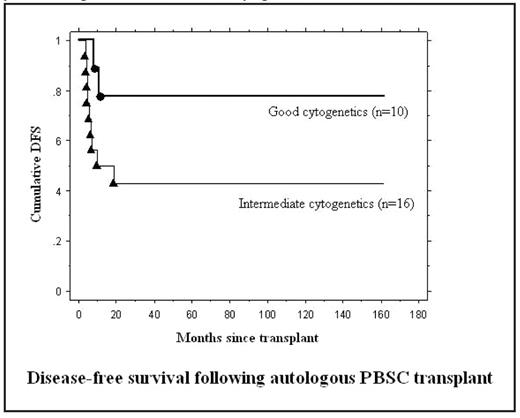Abstract
INTRODUCTION: Autologous PBSC transplant is an important yet evolving treatment modality for patients with AML. However, the ideal mobilization regimen from which to collect PBSC remains in question. Previous reports have indicated that highdose cytarabine with etoposide is both safe and effective in terms of successful PBSC procurement, subsequent engraftment, and disease outcome.
METHODS: At our institution from 1994 to 2007, 38 consecutive patients with de novo non-promyelocytic AML in first complete remission following conventional induction chemotherapy were consolidated with high-dose cytarabine (2000mg/m2 IV q12h × 8 doses, days 1–4) and etoposide (40mg/kg IV over 96h) followed by G-CSF 5 mg/kg subcutaneously starting d14 until completion of PBSC collection. Patients underwent myeloablative therapy with busulfan (1mg/kg po q6h × 16 doses, days –7 to -4) and etoposide (60 mg/kg IV over 10h, day -3) with PBSC infusion occurring on day 0 with daily G-CSF 5 mg/kg. Data regarding stem cell yield, engraftment and patient outcome was collected retrospectively.
RESULTS: The average patient age was 44 years (range 19–70). Following consolidation, at least 2×106 CD34 cells/kg were isolated from all 38 patients with a median of 9.4×106 (range 2.2–43) CD34 cells/kg over a mean of 4 collections (range 1–11). Overall, 36 of 38 (95%) remained in CR and went onto PBSC transplant (one died from infectious complications during consolidation, one relapsed before transplant). The median number of stem cells infused was 8.8×106 CD 34 cells/kg (range 2.2–47). All 36 patients engrafted with the mean number of days to neutrophil recovery (ANC>500) being 11 (range 8–17) and the mean number of days to platelet recovery (>20,000) being 12 (range 8–19). Disease-free outcomes in patients undergoing PBSC transplant while in CR1 are presented in Figure 1. The 3y overall survival in all pts was 66%, and 56% at 5y. For good-risk cytogenetic patients, 3y OS was 78% and the 5y OS was 75%. For intermediate-risk cytogenetic patients, OS was 47% and 36% at 3y and 5y respectively. Three patients with poor cytogenetics were autulogously transplanted. One patient relapsed at day 111 and expired at day 450. The second patient remains in CR at day 246. The third patient relapsed at day 104 and expired at day 322.
CONCLUSION: In patients with de novo non-promyelocytic AML in CR1, consolidation with high-dose cytarabine plus etoposide is safe and provides excellent yield of PBSCs upon growth factor accelerated hematological recovery. Subsequent engraftment after autologous transplanation is rapid. Our outcomes support the viability of this regimen in patients with good and intermediate-risk cytogenetics.
Kaplan-Meier analysis of disease-free survival following autologous PBSC transplant. Cytogenetic analysis was unavailable in 5 patients, and 1 patient was lost to follow-up.
Kaplan-Meier analysis of disease-free survival following autologous PBSC transplant. Cytogenetic analysis was unavailable in 5 patients, and 1 patient was lost to follow-up.
Disclosures: No relevant conflicts of interest to declare.
Author notes
Corresponding author


This feature is available to Subscribers Only
Sign In or Create an Account Close Modal